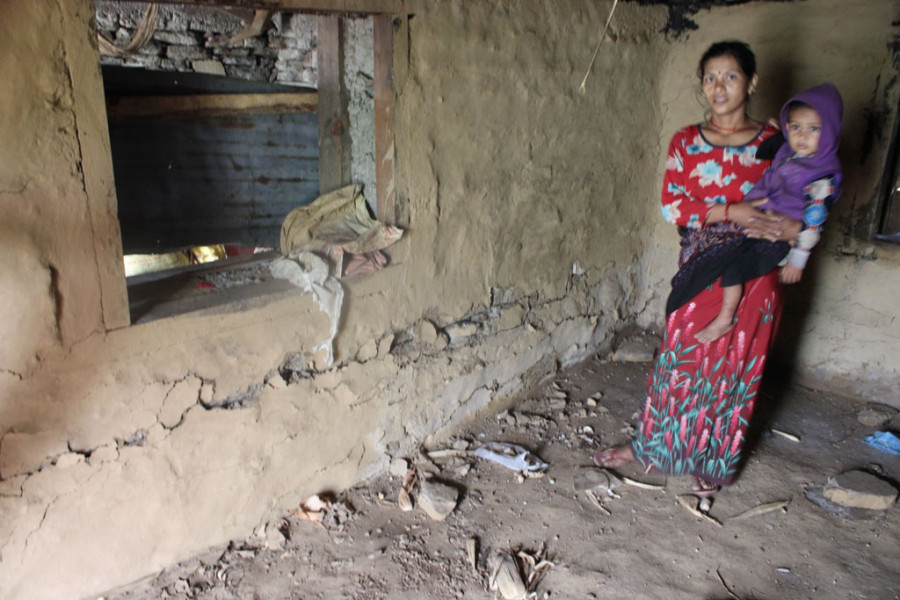Gandaki Province
They were struck by earthquakes in 2015, now the ground beneath them is crumbling
Residents of Khanigaun in Gorkha district have left their newly built homes after the landmass developed cracks and rains caused soil erosion.
Hariram Upreti
Since August 13, 73-year-old Manamaya Gurung and 64-year-old Bishnumaya Gurung of Khanigaun in Dharche Rural Municipality-7 have been living under tarpaulin tents on the premises of Gorakhnath Basic School.
The two 2015 earthquake survivors had to vacate their house after their one-room house built after the earthquake started developing cracks.
Several Khanigaun villagers have vacated their homes and have been living under tents since August 13. A total of 32 families have been displaced this monsoon due to unsafe living conditions in their village which has suffered superficial cracks.
The two sisters, Manamaya and Bishnumaya, built the one-room house using their social security allowances. Bishnumaya lives with a physical disability and needs help to move around. “After the 2015 earthquake, we went to live with our brother so our name was not enlisted on their list of grant beneficiaries to rebuild our house,” said Manamaya. “We built the current house with our single women allowance, but it looks like we are going to lose the house to landslides.”
Khanigaun is still suffering from the aftermath of the earthquake. The landmass has developed cracks and the monsoon rain has caused soil erosion. Nineteen families were displaced after two years following the earthquake as their houses became unlivable due to the growing fissures in the ground. Some of the displaced families are still taking shelter at their relatives’ places or under tents.
Heavy rainfall last week displaced 32 households in Gairigaun and Kaphalpakha of Dharche Rural Municipality. The villagers left their homes after cracks started appearing on the land their houses sat on.
Sunita BK, a 30-year-old woman from Gairigaun, has been under a tent since August 14, after the floor started developing cracks. BK said that a week ago, after the rain, small cracks started appearing on the walls of her house. “Then one morning, the crack had turned into a huge fissure. The walls started buckling under the weight of the roof,” she said.
She is currently living under a tent with her newborn, six-year-old son, eight-year-old daughter and her 58-year-old father-in-law. “My children and my father-in-law have started falling ill due to the cold. When it rains, water seeps through the ground and the tent leaks,” said Sunta.
Chanchala BK, a 23-year-old man also from Gairigaun, built a house at the cost of Rs500,000. The house was completed three months ago. On Saturday, Chanchala saw several cracks in her new house and moved to a tent. Chanchala said that her one-and-a-half-year-old son has also started falling sick. “My son is not keeping well and I am worried. We can’t even go back to our house, because it’s not safe,” she said.
Purni Gurung from Kaphalpakha also took a loan of Rs200,000 to build a house. She has yet to repay the loan, but the house has become unlivable due to cracks on the ground and a collapsed roof.
Settlements in Darche Rural Municipality started developing cracks after the earthquake and since then every monsoon season the cracks grow wider, says Purni. “The cracks on the ground grow wider and deeper every year during the rainy season. If this continues, there will be no villages left in the rural municipality,” she said.
According to Puta Bahadur Gurung, another local of Khanigaun, the landmass started cracking after the post-earthquake reconstruction started. “The National Reconstruction Authority did not conduct feasibility tests before they started reconstruction,” he said. “There were 21 houses in Khanigaun built after the earthquake under the National Reconstruction Authority. All of those houses now have become inhabitable because the land they sit on is cracking. Several Khanigaun villagers have become homeless and landless squatters,” he added.
According to Rakesh Gurung, ward chairman of Dharche-7, the National Reconstruction Authority conducted an on-site study three years ago and suggested relocating the locals of Khanigaun because the land of the village has become weak and unstable due to the earthquake. Several meetings have been conducted, and places have been shortlisted to relocate the Khanigaun villagers, but no official decision has been made so far.
“After last week’s rainfall, Khanigaun villagers have left their homes,” said Rakesh. “The rural municipality distributed tarpaulins to the locals, and efforts are being made to distribute warm clothes and blankets. But this is only a temporary solution, the villagers must be relocated to a safer place soon.”
According to him, there were plans to move the Khanigaun locals to the Gorkha market area in Gorkha Municipality, but the locals demanded they be given agricultural land too for farming purposes. “So that plan was also dropped. Now we are making plans to relocate the village to someplace else soon as it has become impossible to live here,” said Rakesh.
There are 83 households in Khanigaun and 51 have sustained damage due to the cracks, added Rakesh.
On Tuesday, 34 hostellers and two teachers from Parbhat Kiran Secondary School, also in ward 7 of the rural municipality, were moved out of the hostel after cracks appeared on the floor of the building, according to Jeet Gurung, principal of the school. “Cracks on the walls and floor started appearing after heavy rainfall last week. We have moved the hostellers and teachers to the school for now.”




 9.88°C Kathmandu
9.88°C Kathmandu.jpg)













